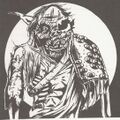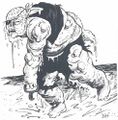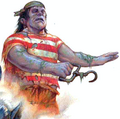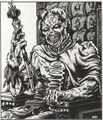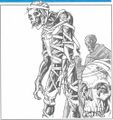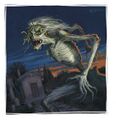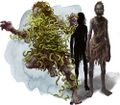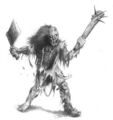Zombie
"Braaaaaiins!"
- – Return of the Living Dead, which popularized the stereotype of zombies being ravenous for brains.
"Zombies man, they freak me out."
- – Dennis Hopper, Land of the Dead.
Zombies are mindless monsters created from humans, usually via their corpses, that are essentially the most exploited type of monster in any and all forms of fictional media, to the point that "zombie fatigue" is very well-established. Such qualities are usually the only common thread between them - everything else depends on the legend, tradition, or other context they're presented in.
IRL zombies
The origin for the term, if not one of the modern concepts, can be found in various African and Haitian Voudou stories and religious practices; the zombie (or "zombi") is created by administering a potion that places its drinker into a state of near-death, where they obey the commands of whoever made the potion. In Voudou practices, zombies are created using a powdery substance created from pufferfish poison that renders the victim into a near-death paralyzed state, effectively making them look "dead" for a long period of time. Of course, this "zombie powder" is obviously impractical for coercing servitude from the heavily paralyzed victim, unless the only command you want to give them is "play dead"-- which is why once the victim is revived from the paralysis using different drugs (based off the Datura genus of hallucinogenic plants) are used to convince them that they really died and are now no longer fully human. If anything, ghouls and other similar undead likely served as the basis for the "original" fictional zombies.
The Servitors are conceptually based on this style of zombie, augmented with cyborg body parts.
Fantasy zombies
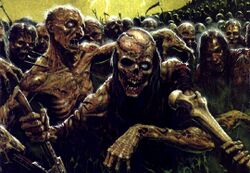
Zombies in fantasy are corpses re-animated through dark magic. Usually, they are animated and controlled by necromancers. They tend to be slow, clumsy, and weak (rigor mortis is a bitch and all), but because they are relatively easy to make in large numbers (especially if there are any graveyards or battlefields close at hand -- in fact, particularly nasty necromancers will do things like annihilate an entire town or army and re-animate everyone), they remain a staple of the undead hordes, right next to skeletons.
Depiction of zombies tend to vary widely through each setting. Some fully or mostly retain their higher brain functions after reanimation that they can still function in death as they did in life, essentially being an undead person. The more popular variant are the ones who have lost themselves but still retain enough intelligence to use weapons, magic, and crude tactics to match their opponents (it isn't a lot but a horde of tenacious armed corpses is not to be underestimated). The other popular type are biters, who's only driving goal in undeath is to take eat living flesh, and won't care that it's burning, shambling against a fence, or reduced to a bloody stump, to do it.
Dungeons & Dragons
Zombies have been a part of Dungeons & Dragons since the beginning, since they are such an iconic monster that is also guilt-free to exterminate. Technically, the largest variety of zombies appeared during Advanced Dungeons & Dragons, due to that game not being able to really handle "levelling up" monsters and thus needing to create more monsters just to fill up the potential opponents slot. Furthermore, most of the zombie species appeared in the Ravenloft setting, due to its status as the Horror D&D Setting.
In AD&D, the following zombies existed:
- Common Zombie: Your standard mindless walking corpse. Comes in humanoid and monster versions.
- Ju-ju Zombie: A zombie created through black magic rituals, typically involving ceremonially draining a living humanoid to death with necrotic energy. This traps a fragment of the soul inside the corpse, creating a dimly intelligent zombie with greater combat abilities and enhanced magical resistances.
- Sea Zombie (also called Drowned One): A standard zombie, but created from somebody who drowned, and thusly specialized for an aquatic environment.
- Zombie Lord: A fully intelligent zombie with a number of mystical powers, mostly the ability to reanimate other corpses as new zombies. This poor-man's-lich is native to the Demiplane of Dread. Downgraded to a template in 3e Ravenloft material, but Pathfinder has its own version as well.
- Cannibal Zombie: Your standard Romero-type roaming mindless flesh-eating corpse. Native to the Demiplane of Dread.
- Desert Zombie: A zombie animated from the dessicated, dried-out carcasses found in desert environments. Again, this was first introduced in the Ravenloft setting.
- Lightning Zombie: Bizarre, sapient zombies that are sometimes born when people die in areas of intense magical energy. This gives them the ability to deliver deadly electrical shocks with a touch.
- Mud Zombie: Despite its name, actually a skeleton caked in thick, gooey, sticky mud, which fouls any wounds it makes and which it can use to try and suffocate anyone it grabs hold of.
- Netherese Zombie: Basically a more powerful version of the Ju-ju Zombie native to the Forgotten Realms.
- Red Zombie: A Mystaran zombie created from the corpse of someone suffering the mutagenic effects of Red Steel.
- Salt Zombie: A blood-drinking zombie strain native to the deserts of Dark Sun, usually forming from either corpses left lying in salt flats or which died of thirst.
- Thinking Zombie: Another Athasian zombie strain, created when a restless spirit possesses its own body to continue its goal. Essentially a variant revenant.
- Zombie Fog: A malign elemental thing of mist that feeds on the souls of the dead, animating corpses as zombie minions to kill its prey.
- Zombie Wolf: what it says on the tin.
- Spawn of Kyuss (formerly known as Son of Kyuss): A zombie filled with infectious worms.
- Coffer Corpse: An undead who is angry that their funerary rites were left unfinished.
Why that "technically" above? 3E made zombie a template in the core rulebooks that can be applied to any corporeal creature with a skeleton system. This makes 3E's possible zombies endless, especially when combined with other templates. This is not the only variant of the zombie template in 3E however, as the Draconomicon introduced the Zombie Dragon template since the normal zombie template produced poor results on a dragon and "dragon zombie" is such a striking image it deserved better. The most dreaded type of zombie in 3rd edition however is the Hydra Zombie, which overcomes a zombie's slowness due to rules quirks.
Magic: the Gathering
The main 2 undead creature types in Magic: The Gathering are zombie and skeleton (vampires also have a creature type). As such things like lichs have the zombie creature type (on their cards).
Innistrad
Innistrad zombies come in 2 flavors. The black zombies are the typical reanimated with black magic zombie that is almost ubiquitous throughout fantasy. The blue zombies are more SCIENCE themed (think Frankenstein's monster).
Amonkhet
The Egyptian themed plane of Amonkhet has made a novel change to the Zombie type by adding white mana zombies. Technically they are mummies, being embalmed and wrapped up nice and tight with a ridiculous amount of linen bandages (probably to keep out that delicious zombie musk), but throwing in a "mummy" creature type after nearly three decades of zombie creatures would be dumb. It is an interesting take on the "sacred dead" schtick that is affiliated with Egyptian lore, though at the end of the day they really are just glorified servants. Some creatures also have an ability called "embalm" where you cast them from the discard pile, making them come back as a copy of themselves, only they are now white zombies. None of them seem particularly powerful though, and while players aren't scrambling to throw white mana into their zombie decks, their art and design is awesome.
Warhammer Fantasy Battle
They are Vampire Count's primary meat shield as well as summoning spell used to annoyed the fuck out of the crossbow men/artillery crew in the back line.
| Vampire Counts Units
| |||
|---|---|---|---|
| Leaders & Characters : | Vampire Count - Vampire Lord - Necromancer - Master Necromancer - Necromancer Lord - Wight King - Banshee - Strigoi Ghoul King | ||
| Troops : | Zombie - Black Knight - Blood Knight - Cairn Wraith - Crypt Horror - Ghoul - Grave Guard - Hexwraith - Simulacra - Skeleton - Spirit Host - Strigany - Swain - Sylvanian Levy - Vargheists - Vampire Thrall - Skeleton Warrior | ||
| Beasts : | Bat Swarm - Dire Wolves - Fell Bats | ||
| Chariots : | Black Coach - Corpse Cart - Coven Throne - Mortis Engine | ||
| Monsters : | Abyssal Terror - Varghulf - Terrorgheist - Zombie Dragon | ||
| Others : | Zombie Pirate | ||
Monster Girls?!
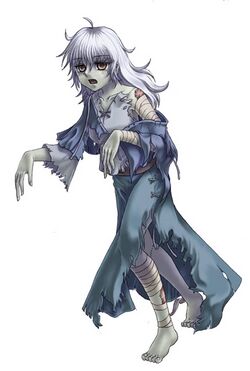
 | This article or section is about Monstergirls (or a monster that is frequently depicted as a Monstergirl), something that /tg/ widely considers to be the purest form of awesome. Expect PROMOTIONS! and /d/elight in equal measure, often with drawfaggotry or writefaggotry to match. |
Yes, even animated corpses get the monstergirl treatment. In fairness to them, these weird dabblings into necrophilia are usually not your standard hideously decayed and mutilated corpses, but beautiful and curvaceous women who just happen to have corpse-colored skin or exotic, almost beauty-mark-like scars on their frames. Behaviour-wise, zombie monstergirls are usually depicted as akin to bimbos: near-golemoid mindless drones who just want pleasure, either searching endlessly for men to screw, or raised as sexual automata by a particularly perverse/desperate necromancer. Those that aren't usually take advantage of the ill-defined barriers between zombie, revenant and wight, so you have a perfectly normal woman who just happens to be dead.
Zombie movies have even exploited this phenomena; a beautiful naked woman is one of the zombies wandering around in the original "Night of the Living Dead", whilst in "Return of the Living Dead 3", the female lead becomes a very attractive zombie and is still weirdly hot even after she pierces herself with random metal and glass junk and starts eating random criminals. To say nothing of the way that B-movies like "Zombie Strippers" exploit it.
Naturally, the zombie appears in the Monster Girl Encyclopedia. Here, the corpse of a woman can get brought back as a lustful rape monster with grey to porcelain white skin, retaining their memories but losing most of their intelligence and reason until they fuck someone enough times. As they have more and more sex, their body and wits are more and more restored until they are as smart as their living selves and more attractive as well. If a zombie's womb was intact or gets restored, she can even give birth to zombie children.
Modern zombies
Zombies in modern settings tend to be the by-products of science rather than necromancy. Some animating agent, usually a chemical or virus (though radiation is not unknown), causes corpses to move around, and for some reason makes them hunger for living flesh. Although this is sometimes explained as the reptilian part of the human brain, which is only centered around finding something to eat, still being prevalent while the other parts responsible for higher reasoning and functions are dead. Thus, without anything really else on their minds but to hunt and eat, all they do for the rest of their undead lives is lumber about and occasionally relentlessly chase someone down to devour, even if they don't have any real reason to do so. This, however, doesn't explain why they don't eat each other...(though Romero Zombies' inability to attack anything that isn't sapient explains this)
Optionally, people who are killed or bitten by zombies may themselves rise again as zombies; in such cases, this reanimation can usually be prevented by destroying or removing the head or incinerating the corpse (decapitation and fire usually work well on putting down zombies post-reanimation as well). George Romero's Night of the Living Dead (1968) movie set the tone for the archetypal modern zombie, to the point that zombies of this archetype are sometimes called "Romero zombies", even though nobody actually says the word "zombie" in the movie itself. George Romero did another zombie movie, Dawn of the Dead (1978), where there's an implied return to the idea of zombies from supernatural origins ("When there's no more room in hell, the dead will walk the earth").
Another more recent trait was the need to eat brains, introduced in the horror-comedy movie Return of the Living Dead (1985). In this movie, the zombies can feel their bodies decompose, and eat brains because it stops the pain (likely via ingesting its endorphins). The zombies in this film are also the same person they were when alive (except psychotically slaved to their hunger for brains), hard to destroy (chop them to pieces and the pieces come after you), and are capable of climbing and running (despite many people thinking 28 Days Later (see below) introduced the running zombie).
More recently, especially in video games, another pattern of zombie has gained popularity: the so-called "fast zombie" or "28 Days Later (2002) zombie" (though the creatures in 28 Days Later are not proper zombies at all, as they are still alive, albeit infected with a rabies-like behavior-altering virus). As the name suggests, these creatures are fast and aggressive and can be terrifying in small numbers, especially if they can infect with a single bite. And though they are still "alive," they are usually incapable of feeling pain, so an attack that would incapacitate a normal human may be shrugged off. Even a blow to a vital organ short of the brain or heart may be ignored, though they'll likely bleed out eventually.
So-called "real world zombies" are mostly just people who have taken some powerful mixture of substances and exhibit zombie-like behavior, including cannibalism. Fortunately, they are not contagious (at least if you don't do the drugs along with them), but do note that while you won't turn into an actual zombie, being bitten by a zombie-like human is still lethal even with a non-critical bite wound, due to infection and/or septic shock if the wound isn't disinfected in time.
See Also
- Revenant - The spiritual predecessor of the zombie.
- Zombie Plague - Zombies in 40k

